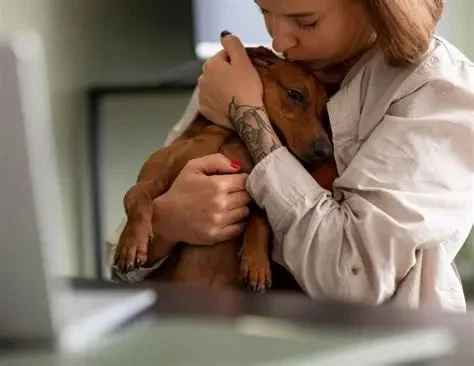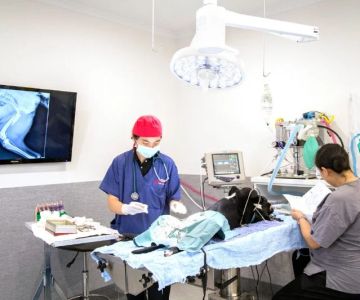
- 1. Understanding Chronic Illness in Pets
- 2. Benefits of Remote Monitoring for Pets
- 3. How Remote Monitoring Works
- 4. Types of Remote Monitoring Tools
- 5. Case Study: Using Remote Monitoring for Pets
- 6. Chronic Disease Management Tips for Pet Owners
1. Understanding Chronic Illness in Pets
Chronic illnesses in pets are long-term health conditions that require ongoing care and management. These illnesses can range from heart disease and arthritis to diabetes and kidney disease. Many pets live with these conditions, and their owners must monitor their symptoms and manage their treatment plans over time. However, traditional methods of monitoring chronic illness can be challenging, especially when it comes to tracking subtle changes in a pet's health between veterinary visits.
Thankfully, remote monitoring tools are now making it easier for pet owners to keep track of their pets' health, ensuring better disease management and improving overall well-being. These advancements are a game-changer in veterinary care, providing owners with more control over their pets' chronic illness management.
2. Benefits of Remote Monitoring for Pets
Remote monitoring for chronic illness in pets offers several key advantages that help improve care and enhance your pet’s quality of life. Let’s explore the benefits:

Webster Veterinary Supply Inc
LexingtonFayette CountyKentucky
2025 Leestown Rd # M, Lexington, KY 40511, USA
1. Early Detection of Health Changes
One of the primary advantages of remote monitoring is its ability to detect subtle changes in your pet’s health that may not be visible to the naked eye. By tracking vital signs such as heart rate, blood sugar, and activity levels, remote monitoring tools can alert you to potential health issues before they become severe. This early detection can be vital in preventing complications and hospitalizations, leading to quicker intervention.
2. Continuous Health Tracking
Remote monitoring provides continuous tracking of your pet’s health data, allowing you to see trends over time. This continuous tracking is especially beneficial for pets with chronic conditions like diabetes, where consistent blood sugar monitoring is essential for effective disease management. It also gives veterinarians a clearer picture of your pet’s condition, leading to more personalized care.
3. Convenience for Pet Owners
Remote monitoring tools give pet owners the flexibility to manage their pets' health from home. Whether you're at work, on vacation, or simply managing a busy schedule, you can stay updated on your pet’s condition in real time. This convenience reduces the need for frequent vet visits and provides peace of mind for owners who might otherwise worry about missing important signs of illness.
3. How Remote Monitoring Works
Remote monitoring technology works by collecting and transmitting data from devices connected to your pet. These devices can monitor various health metrics, including:
1. Vital Signs Monitoring
Many remote monitoring systems focus on monitoring vital signs such as heart rate, respiratory rate, and temperature. These metrics are essential for detecting changes in your pet’s overall health.
2. Activity Tracking
Activity trackers can measure how much your pet moves throughout the day, helping you monitor their level of physical activity. For pets with conditions like arthritis or heart disease, maintaining a consistent activity level is crucial for managing their symptoms.
3. Symptom Logging
Some remote monitoring systems allow pet owners to log symptoms, such as changes in appetite, vomiting, or difficulty breathing. This can provide valuable insight into a pet’s condition, allowing you and your veterinarian to adjust treatment plans accordingly.
4. Types of Remote Monitoring Tools
There are a variety of remote monitoring tools available for pet owners, each designed to track different aspects of health. Some common types include:
1. Wearable Devices
Wearable devices, such as collars and vests, are equipped with sensors that monitor vital signs, activity levels, and even sleep patterns. These devices can provide real-time data, which can be synced with your smartphone for easy access.
2. Smart Feeders and Medication Dispensers
Smart feeders and medication dispensers are particularly helpful for pets with chronic illnesses that require regular feeding or medication. These tools can automatically dispense food or medication at scheduled times and send alerts to pet owners if doses are missed.
3. Health Apps
Health apps designed for pet owners can help track your pet’s medical history, medication schedules, and general health data. Many of these apps sync with other monitoring devices, making it easy to manage your pet’s chronic illness from a single platform.
5. Case Study: Using Remote Monitoring for Pets
Let’s take a look at a real-world example of how remote monitoring can assist in managing chronic illness in pets. Mia, a 7-year-old Beagle, was diagnosed with early-stage kidney disease. Her owners were initially overwhelmed by the prospect of managing her health at home. However, after they began using a wearable health monitor, Mia’s owners were able to track her hydration levels and activity patterns more effectively.
Using the data collected, they noticed that Mia’s activity levels dropped significantly on certain days, and her drinking habits changed. These changes prompted a visit to the vet, where Mia’s kidney function was reassessed, and adjustments were made to her treatment plan. The ability to monitor Mia’s health remotely gave her owners peace of mind and helped them provide timely care when needed.
6. Chronic Disease Management Tips for Pet Owners
Managing chronic illness in pets requires dedication and consistency. Here are some additional tips for pet owners to improve their pet's quality of life:
- Stick to a Routine: Consistency in medication, feeding, and exercise is key to managing chronic illness. Use remote monitoring tools to help keep track of schedules.
- Regular Vet Check-ups: Even with remote monitoring, regular visits to the vet are essential to assess your pet’s overall health and adjust treatment plans as necessary.
- Provide a Comfortable Environment: Ensure your pet has a safe, comfortable, and stress-free environment. This includes a cozy resting area, temperature control, and avoiding stressful situations.
- Monitor for Changes: Use remote monitoring tools to detect early signs of deterioration or improvement in your pet's condition. Regular monitoring helps you catch any issues before they become more serious.
Remote monitoring technology is revolutionizing chronic illness management for pets, providing owners with the tools they need to take proactive steps in their pets' health care. To find the best products and services for your pet’s chronic illness management, visit Pet & Puppy.








 1214 Central Store0.0 (0 reviews)
1214 Central Store0.0 (0 reviews) Burlington Pet Hospital4.0 (118 reviews)
Burlington Pet Hospital4.0 (118 reviews) ArkVets4.0 (426 reviews)
ArkVets4.0 (426 reviews) Hartzell Veterinary Service: Charles W. Hartzell, DVM and Sue Ann Hartzell, DVM4.0 (105 reviews)
Hartzell Veterinary Service: Charles W. Hartzell, DVM and Sue Ann Hartzell, DVM4.0 (105 reviews) Noah's Ark Animal Hospital4.0 (163 reviews)
Noah's Ark Animal Hospital4.0 (163 reviews) Jasper Pet Clinic4.0 (285 reviews)
Jasper Pet Clinic4.0 (285 reviews) Transitioning Training Methods as Pet Ages: Adapting Techniques for Senior Pets
Transitioning Training Methods as Pet Ages: Adapting Techniques for Senior Pets How to Read & Understand Pet Nutrition Labels for Your Pet's Health
How to Read & Understand Pet Nutrition Labels for Your Pet's Health How to Choose the Right Pet Supplement Brand: Essential Tips for Pet Owners
How to Choose the Right Pet Supplement Brand: Essential Tips for Pet Owners How Much Should You Feed Your Pet? Portion Guide by Age & Breed
How Much Should You Feed Your Pet? Portion Guide by Age & Breed How to Create a Pet Health Journal: Metrics to Track for Better Pet Care
How to Create a Pet Health Journal: Metrics to Track for Better Pet Care What Breed-Specific Health Issues You Should Be Aware Of
What Breed-Specific Health Issues You Should Be Aware Of